Adrian Collins's Blog, page 19
May 24, 2025
REVIEW: I Can Fix Her by Rae Wilde
Like all great horror authors, the messages of Rae Wilde’s books work for both a specific and a universal audience. From her triumphant revenge tale Merciless Waters through to her resplendently incel-baiting-titled collection I Do Not Apologize for My Position on Men, Wilde has developed, through her queer horror, an unapologetic, raw, feminism which examines the freedom that comes with being allowed to be imperfect. But Wilde’s work has also covered universal themes of rage and love and self-hatred. Nowhere is this more true than her latest effort, I Can Fix Her, out from Clash Books June 3, a literary horror time-travel lens into a toxic queer relationship trapped in a grim space-time purgatory that also functions as a trauma-hallucinogen thought experiment for anyone, queer or not, who’s wasted part of their life trying to love or be loved in a relationship that all your friends know is inexplicable masochism. This one really fucked me up, and I love it deeply for that.
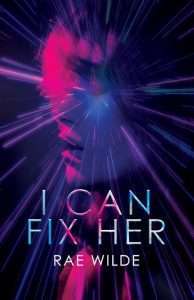 It begins with Johnny spotting her ex-girlfriend, Alice, at the local café, complete with a sense of déjà vu. Angry about their break-up, she’s compelled to give her ex a second chance and soon she’s back at Alice’s apartment. What happens next is a week, all spent in the apartment, where it quickly becomes clear that nothing is what it seems, reality is not behaving normally, and Johnny’s goal of changing the toxic cycle that drives their relationship will be harder to achieve than she realised.
It begins with Johnny spotting her ex-girlfriend, Alice, at the local café, complete with a sense of déjà vu. Angry about their break-up, she’s compelled to give her ex a second chance and soon she’s back at Alice’s apartment. What happens next is a week, all spent in the apartment, where it quickly becomes clear that nothing is what it seems, reality is not behaving normally, and Johnny’s goal of changing the toxic cycle that drives their relationship will be harder to achieve than she realised.
I don’t know if I’ve given that plot justice, but rest assured, I Can Fix Her is not just two people talking about their relationship for a week, although given Wilde’s sublime prose and dialogue I’d still read that book in a shot. Rather, it’s a perverse cyclone of fever nightmare logic, symbolic imagery whose cleverness won’t become apparent until you’ve read the denouement, ultra visceral gore, and a descent into cosmic madness. I imagined much of it like the scene from the film Inception where dream logic is introduced and buildings arch into the sky at impossible angles, complete with Hans Zimmer horns blaring out the sapphic chain of self destruction.
But if that sounds too abstract, be assured there’s a distinct theme tunnelling its way through I Can Fix Her like a possessed tapeworm: how one person in a relationship can hammer their head against the other, desperate to change them, unwilling to see their own self-hatred, unwilling to accept that the only change is to leave. Wilde has ruthlessly identified how pathological this form of relationship is; how perverse it can be; how it turns love into this violent, self-immolating thing that defies sense. If you know you know, and this book’s coming for you. That said, it’s a mistake to make it too universal and forget this is a sapphic relationship. These women are fucking up in plain sight—that’s the point. Queer women will see further angles than I as Captain Straight of the USS Man did. Nonetheless, this book captured my past sins more than anything I’ve read for a while, regardless of the author’s intent.
And then there’s the denouement, which ties things up narratively and thematically. As much as I loved what prefaced it, I needed this ending—a cold, clear-eyed, heartbreaking counterpoint to the abstract madness before it, pitch-perfect dialogue encapsulating the cyclical inevitability of our toxic delusions. It’s a brilliant ending—if anyone accuses this book of being confusing, then they fell asleep before this. It introduces the idea, perhaps even more revelatory than the themes discussed earlier, of the divisibility of the self; how you can watch yourself from afar, knowing what you’re doing is wrong even as you’re compelled to do it. How one day, your future self will wonder if that was ever really you who fucked up so badly. Is it hopeful? Is it depressing? Who knows—maybe that’s the point.
Overall, with I Can Fix Her, Rae Wilde has taken risks and absolutely no prisoners. If you’ve ever been in a relationship where you’re both bad for each other, then this nightmarish groundhog day of surreal narrative genius is coming for your jugular and trust me—you need to bleed.
Read I Can Fix Her by Rae WildeThe post REVIEW: I Can Fix Her by Rae Wilde appeared first on Grimdark Magazine.
May 23, 2025
REVIEW: Behooved by M. Stevenson
Behooved by M. Stevenson takes a time-worn trope – arranged political marriage – and twists it in this charming and quirky subverted fairytale, perfect for readers who like their grimdark so light that it almost isn’t grimdark at all!
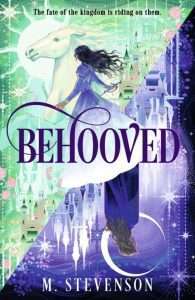 Bianca is the second daughter of House Liliana, one of the few ruling houses of Damaria. When the threat of war from the neighbouring kingdom of Gildenheim arrives in the form of a treaty, requesting the marriage of Bianca to Prince Aric, the heir-apparent, (and rumoured murderer of the Queen) Bianca must put her duty first. After an assassination attempt on Bianca and Aric’s wedding night goes awry, Aric is magically transformed into a horse, and Bianca is now the prime suspect of a supposed regicide. So what does she do? She mounts her husband and rides off to safety, of course! At the setting sun, Aric returns to human form, and both husband and wife discover that the assassination attempt is actually part of a much larger plot against the throne. Tensions rise and feelings grow, while the fate of the kingdom rides on Bianca and Aric’s ability to unravel the curse and protect the throne.
Bianca is the second daughter of House Liliana, one of the few ruling houses of Damaria. When the threat of war from the neighbouring kingdom of Gildenheim arrives in the form of a treaty, requesting the marriage of Bianca to Prince Aric, the heir-apparent, (and rumoured murderer of the Queen) Bianca must put her duty first. After an assassination attempt on Bianca and Aric’s wedding night goes awry, Aric is magically transformed into a horse, and Bianca is now the prime suspect of a supposed regicide. So what does she do? She mounts her husband and rides off to safety, of course! At the setting sun, Aric returns to human form, and both husband and wife discover that the assassination attempt is actually part of a much larger plot against the throne. Tensions rise and feelings grow, while the fate of the kingdom rides on Bianca and Aric’s ability to unravel the curse and protect the throne.
Grimdark readers – be warned! Whilst the synopsis does highlight a few themes that you would typically find in many grimdark stories: wars, assassinations, murder; it is exceptionally light in its execution. Behooved does not take itself seriously at all, pottered with all the best horse puns you could think of, and hand in hand with the type of hyperbolic scenes you’d often find in children’s fairytales. Honestly, it was almost a breath of fresh air!
The bulk of the story focuses on the budding romance between Bianca and Aric, framed with each of their humorous personalities. The characters subvert typical fairytale norms; with Bianca being the protector, experienced with a sword, whilst Aric favours the comforts of a book, and questions whether he is truly made for the throne. This refreshing take is coupled with the fact that Bianca also suffers from a chronic illness, which is not at the forefront of her character at all, and is simply just something that she deals with. Alongside the queer-normative setting of the magical world, it was a nice change from the normal societal expectations that often frames typical fairytales.
My major qualm with this book was that the reveal of the attempted murder plot was too simple, and lacked in fulfilling the potential it had to build up a really elaborate scheme to overthrow the throne. It almost felt like an epilogue was missing, which could have gone into more detail regarding the assassination attempt and subsequent coup. I also wished that the magic system had been explored more.
For those looking for a truly grimdark-esque fairytale, you won’t find it here. However, if you’re looking for something light and fun, it would simply behoove you to pick this up!
Read Behooved by M. StevensonThe post REVIEW: Behooved by M. Stevenson appeared first on Grimdark Magazine.
May 22, 2025
EXCLUSIVE: Daniel Polansky to return to Low Town in new novella
Daniel Polansky’s stories and characters are right in the sweet spot of the grimdark fanbase. Grit, snark, pitch darkness, amazing characters, brutal stories, black humour, badassery, betrayal, weakness, exploitation, strength … I could go on and on about the kind of awesomeness Polansky brings to the page.
Last year I finally got off my arse and started reading The Straight Razor Cure. It was so completely unputdownable I that I finished the trilogy (Tomorrow, the Killing and She Who Waits) later that year and rolled on straight into A Drink Before we Die.

When I was looking at possible novella authors for our 2026 catalogue, Polansky naturally came straight to mind—especially when you consider his absolute mastery of the novella format evident in The Builders. Knowing that he had expressed zero interest previously in returning to Low Town, I said that I’d be pretty much interested in whatever he felt like writing.
Much to my surprise, and I hope to the celebration of Low Town fans, Polansky said he felt like he had a Low Town story that needed to be told.
In July of 2026, Grimdark Magazine will be publishing a yet-to-be-named novella by Daniel Polansky set in the Low Town world, with a worldwide English rights deal in print, ebook, and audio.
When I asked Polansky about returning to Low Town, he said:
 “
I never, ever, ever, had the slightest inclination to return to the world of Low Town. I am uneasy with sequels and dislike franchises. I get bored easily; the fun of a new project is figuring out the voice and structure, and once that’s been determined, much of the fun is lost. Then one day it occurred to me there was a way to do a Low Town book which would feel fresh to write (and hopefully to read) and still indulge some of my half-forgotten low-fantasy chops. By happy coincidence, Adrian reached out to me not that long afterward, and here we are.”
“
I never, ever, ever, had the slightest inclination to return to the world of Low Town. I am uneasy with sequels and dislike franchises. I get bored easily; the fun of a new project is figuring out the voice and structure, and once that’s been determined, much of the fun is lost. Then one day it occurred to me there was a way to do a Low Town book which would feel fresh to write (and hopefully to read) and still indulge some of my half-forgotten low-fantasy chops. By happy coincidence, Adrian reached out to me not that long afterward, and here we are.”
We’ll have plenty more updates to come in the following months. I can’t wait to get back into Low Town, just as much as a publisher as a rabid fan of those books.
The post EXCLUSIVE: Daniel Polansky to return to Low Town in new novella appeared first on Grimdark Magazine.
May 21, 2025
REVIEW: You’ve Lost a Lot of Blood by Eric LaRocca
Eric LaRocca’s You’ve Lost a Lot of Blood is a dark and moody book about a serial killer, his collected writings, and his relationship with others and himself. A story-within-a-story, told through different documents, is not new to the horror genre, but LaRocca handles it in such a way that makes its blood-soaked, nigh cosmic horror-style tale such an awesome read.
 You’ve Lost a Lot of Blood shows us Martyr Black and his partner Ambrose Thorne, two people in toxic relationships with not only each other, but also with each others’ obsession with violence. Told through poems, transcriptions, and stories written by Martyr himself, You’ve Lost a Lot of Blood is also the titular title of a novella written by Martyr about Tamsen and Presley, a game designer and her little brother sent to a mysterious mansion to work on a game created by the equally mysterious Abbus Zimpago.
You’ve Lost a Lot of Blood shows us Martyr Black and his partner Ambrose Thorne, two people in toxic relationships with not only each other, but also with each others’ obsession with violence. Told through poems, transcriptions, and stories written by Martyr himself, You’ve Lost a Lot of Blood is also the titular title of a novella written by Martyr about Tamsen and Presley, a game designer and her little brother sent to a mysterious mansion to work on a game created by the equally mysterious Abbus Zimpago.
LaRocca’s writing is ethereal, even when describing horrific bloodbaths and eerie confessions to murder. You feel a level of otherworldliness from his writing, right down to the sentence level. It’s an atmospheric ride that will stay with you long after you put the book down.
The non-novella parts feel like profiles of the man as we get his thoughts, his mores, and his feelings towards his partner Ambrose and their shared crimes. You feel what he feels, see how he sees the world. Ambrose feels like the perfect foil for Martyr, someone who both understands and challenges him at every step. Occasionally, you may forget these two are murderers while they have arguments about philosophy or morality. You’ve Lost a Lot of Blood, for all of its violence and musings on death, is a story about relationships with those closest to us. This relationship plays out between Presley and Tamsen in the novella portion; Tamsen has her own troubles with taking care of her kid brother while also trying to have a life for herself. It’s fascinating to see the novella holding up a mirror to the character writing it.
While a short read, You’ve Lost a Lot of Blood packs a lot in its pages. The horror takes its time to reveal itself, and it exists under the surface for most of the book, but when it hits, it hits hard. The book itself seems like its drenched in blood: the madness that Tamsen walks into, and the madness that Martyr engages in, saturate each sentence.
What I do wish had been included in the book was more about Martyr from another character’s perspective. We get everything from Martyr’s view, and can only really view him as “serial killer”. So much of it is metaphorical, or biased based on the narrator’s views of things. Ambrose is certainly a character who knows Martyr the best, so having a viewpoint from him would’ve helped things along at getting the audience to understand Martyr better. It would’ve been interesting to get Ambrose’s take on his significant other and the crimes they commit.
I also think the novella portion of You’ve Lost a Lot of Blood could’ve connected more with the narrative of Martyr Black. There’s a twist regarding the novella and the writer, but I wish it connected a bit more to serve as a reflection of the person writing it.
You’ve Lost a Lot of Blood is a fascinating look into the mind of a serial killer that builds and builds until it unleashes a wave of horrific violence and blood upon the reader. I’ve been a fan of LaRocca’s for a few years now, so it was delightful to find this little book, its insides dripping with blood and fear.
Read You’ve Lost a Lot of Blood by Eric LaRoccaThe post REVIEW: You’ve Lost a Lot of Blood by Eric LaRocca appeared first on Grimdark Magazine.
May 20, 2025
REVIEW: The Girl with All the Gifts by M.R. Carey
Following its original publication in 2014, The Girl with All the Gifts by M.R. Carey quickly became my favorite zombie book, an expertly crafted post-apocalyptic thriller that ponders what it means to be human while delivering a steady onslaught of undead action. Upon revisiting the novel this month, my respect for The Girl with All the Gifts has grown to even greater heights with a newfound appreciation of the emotional depth in M.R. Carey’s character work.
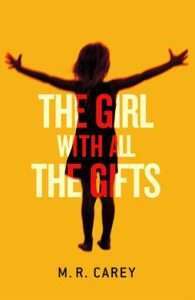 The Girl with All the Gifts takes place in a post-apocalyptic Britian twenty years following a mass fungal infection that turns humans into zombies, known in the book as “hungries” for their insatiable hunger for devouring human flesh. The infection is extremely contagious, spreading through contact with bodily fluids or airborne spores. Unfortunately, there is no known cure.
The Girl with All the Gifts takes place in a post-apocalyptic Britian twenty years following a mass fungal infection that turns humans into zombies, known in the book as “hungries” for their insatiable hunger for devouring human flesh. The infection is extremely contagious, spreading through contact with bodily fluids or airborne spores. Unfortunately, there is no known cure.
As the novel opens, a group of military scientists are researching a potential cure by studying a new generation of zombie children who show notable human-like qualities. One of these children, ten-year-old Melanie, shows remarkable intelligence and perhaps even a capacity for human emotions. As the star student in her class of zombie children, Melanie forms a special bond with her teacher, Miss Justineau, who becomes something of a surrogate mother for her.
The Girl with All the Gifts explores the meaning of humanity in a world where humans are at the brink of extinction. While most fungal-infected hungries no longer have functional human brains, this second generation represented by Melanie and her classmates displays human intelligence, creativity, emotions, and possibly even self-determination. Do these traits qualify the children as human? Or are they, perhaps, the next leap forward in the evolution of our species?
The thematic depth of The Girl with All the Gifts pairs perfectly with M.R. Carey’s emotionally complex character work. The relationship between Melanie and Miss Justineau is particularly well done, leading up to M.R. Carey’s emotional gut-punch of an ending.
M.R. Carey’s novel was also adapted into a 2016 film of the same name directed by Colm McCarthy and starring Gemma Arteron, Paddy Considine, Glenn Close, and Sennia Nanua. The film is a faithful adaptation of the novel, which is not surprising since M.R. Carey also wrote the movie’s screenplay. The actors’ performances are outstanding across the board, and the zombie-strewn post-apocalyptic setting is especially well done given the modest budget for the film.
Altogether, The Girl with All the Gifts remains an inordinately well-written and thought-provoking read more than a decade after its original publication. In my mind, M.R. Carey’s book strikes a perfect balance between science fiction and horror and represents the pinnacle of grimdark zombie fiction. Fans of the book are also encouraged to watch the excellent 2016 movie adaptation.
Read The Girl with All the Gifts by M.R. CareyThe post REVIEW: The Girl with All the Gifts by M.R. Carey appeared first on Grimdark Magazine.
May 19, 2025
REVIEW: The Last of Us S2
After a stunning first season, how could The Last of Us S2 improve upon what has gone before, after the brutal ending it follows, and would it be able to adapt a game that is one of the most critically acclaimed of all time? The Last of Us S2 builds upon perfection and adds further depth to the post-apocalyptic world inhabited by Joel and Ellie as the pair start the season with some tension.
 This is a series that deserves to be watched and enjoyed (if that is really the right word here) without any spoilers. The world of The Last of Us S2 is brutal and unforgiving and the showrunners want you to know that from the start. There’s no easing the audience in. It hits you like a golf club to the head (multiple times) and only relents to allow you a moment to breathe and appreciate the beauty in darkness before smashing you in the face again. There’s genuine peril for our protagonists as members of the WLF (Washington Liberation Front) look for revenge for Joel’s attack at the end of the last season and the infected begin to show signs of evolution that can only lead to trouble for the settlement that Joel and Ellie now call home. It’s an action-packed season with new interesting characters added to the stunning world. New factions are introduced, each with their own ideals and goals causing them to be at odds with one another as they attempt to carve out a piece of life in the hell that they now live in. Some have looked to faith and a time before technology (Seraphites) whilst others rely on the law and order of the military (WLF). Ellie is of course caught between them all and new addition Dina played brilliantly by Isabela Merced (Alien: Romulus, Superman) is a standout performer as she joins Ellie on her mission across Seattle. It was also great to see the menacing Jeffrey Wright acting as the same character he voiced in the game, Isaac. I’ve loved to see the little links between game and TV characters across the two seasons and it is something that will be enjoyed by the game’s original audience.
This is a series that deserves to be watched and enjoyed (if that is really the right word here) without any spoilers. The world of The Last of Us S2 is brutal and unforgiving and the showrunners want you to know that from the start. There’s no easing the audience in. It hits you like a golf club to the head (multiple times) and only relents to allow you a moment to breathe and appreciate the beauty in darkness before smashing you in the face again. There’s genuine peril for our protagonists as members of the WLF (Washington Liberation Front) look for revenge for Joel’s attack at the end of the last season and the infected begin to show signs of evolution that can only lead to trouble for the settlement that Joel and Ellie now call home. It’s an action-packed season with new interesting characters added to the stunning world. New factions are introduced, each with their own ideals and goals causing them to be at odds with one another as they attempt to carve out a piece of life in the hell that they now live in. Some have looked to faith and a time before technology (Seraphites) whilst others rely on the law and order of the military (WLF). Ellie is of course caught between them all and new addition Dina played brilliantly by Isabela Merced (Alien: Romulus, Superman) is a standout performer as she joins Ellie on her mission across Seattle. It was also great to see the menacing Jeffrey Wright acting as the same character he voiced in the game, Isaac. I’ve loved to see the little links between game and TV characters across the two seasons and it is something that will be enjoyed by the game’s original audience.
The heavy work of the show is carried by Bella Ramsay as Ellie. Some people have moaned about her casting but her acting is incredible across the season and really carries the season forward as she manages the emotional depth of the show. The Last of Us S2 works so well because of her. The mix of rage, love, grief, loss, joy is all there with each little movement and she truly understands the character of Ellie. New to the season and playing the divisive Abby is Kaitlyn Dever. Again, her acting is mesmerising and she is someone the audience will love to both hate and pity in the story and the series only works with these two phenomenal actresses bringing their A-game. For those of us who want action along with an emotional core, there is a battle scene early on that reminded me of some of the best episodes of Game of Thrones and looking back, it is probably one of the best episodes put on a TV screen. HBO really knows how to do this stuff.
Intense, beautiful, and as gut-wrenching as the first season. The Last of Us S2 adapts one of the best games ever made and doesn’t falter. Great performances by its stars, stellar writing, and some amazing action scenes mean that you will not be disappointed by this great series.
The post REVIEW: The Last of Us S2 appeared first on Grimdark Magazine.
May 18, 2025
REVIEW: Breathe In, Bleed Out by Brian McAuley
Let’s talk about movies for a second. I’m a slasher hound, and so it’s no surprise to learn that one of my favourite horror films is Scream, the game-changing slasher whodunnit, much copied, never bested. Slasher fans know that it’s not so much legendary director Wes Craven but the scriptwriter Kevin Williamson who we have to thank. Scream has been much aped since for its wink wink meta which changed the horror landscape, but Williamson knew that a great slasher mystery thrives on three things: characters you care for, kills you remember and a mystery plot with more red herrings than a bloody fishing lake. You know who else likes Scream? Brian McAuley, because Breathe In, Bleed Out, his fourth slasher, out from Poisoned Pen Press September 2, is a love letter to all the elements above that make the perfect stabby whodunnit while driving the genre forward in new ways. The master of slasher is back, and my god is he here to slay.
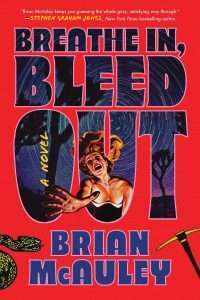 The setting for Breathe In, Bleed Out is a remote spiritual healing retreat in Joshua Tree, the wilderness of Southern California being, it turns out, a perfect location, up there with the more traditional cabin in the woods or campsites in terms of isolation and sense of unease. Attending this retreat, which is headed by the marvellously named potential bullshitter Guru Pax, is a group of young friends, the ostensible aim being to help our protagonist Hannah heal her trauma—her trauma being losing her fiancé on a mountain hike a year before. Seems a good plan—get in touch with your inner self—but when a killer starts taking that a little too literally, this place of healing becomes a fight for survival in the best slasher traditions, with everyone from retreat staff to friends to out-of-towners a suspect.
The setting for Breathe In, Bleed Out is a remote spiritual healing retreat in Joshua Tree, the wilderness of Southern California being, it turns out, a perfect location, up there with the more traditional cabin in the woods or campsites in terms of isolation and sense of unease. Attending this retreat, which is headed by the marvellously named potential bullshitter Guru Pax, is a group of young friends, the ostensible aim being to help our protagonist Hannah heal her trauma—her trauma being losing her fiancé on a mountain hike a year before. Seems a good plan—get in touch with your inner self—but when a killer starts taking that a little too literally, this place of healing becomes a fight for survival in the best slasher traditions, with everyone from retreat staff to friends to out-of-towners a suspect.
The first thing to note is that McAuley, for all the fun he’s having with the setting and taking the mighty piss out of the cynical mash-up of cultures (sound baths! Yoga! desert hallucinogens!) that can compose these spiritual retreats, cares for his characters—and wants you too, as well. Hannah’s tragedy and trauma is established immediately in the book’s opening chapter through a genuinely poignant (and classically tricksy) opening that roots you to her cause. Then McAuley pulls a neat trick. Her friends seem frankly awful; subtler Gen Z takes on the old slasher stereotypes—there’s the cynical boorish finance guy in place of the jock; the yoga-loving, condescending “just want to help everyone” type in place of the dumb blonde, etc. But McAuley uses the concept of a spiritual retreat—where people come to terms with their own dickishness—in a genius way to put you in their heads as they decide to be better and then, well, kill them. It’s a brutal way to make you feel for initially unlikable twenty-somethings, and a narrative masterstroke, as well as a witty commentary on the falsity of convenient self-realization.
But this is slasher, and we’re also here for the kills and the thrills. And boy, is there a better death-scribe than McAuley in horror at the moment? The kills in Breathe Out, Bleed In are art. In his afterword, he notes how he wanted to emulate Final Destination-style deaths (the Final Destination films being slashers of course, with death as Ghostface) and I think it’s safe to say he achieved this; these deaths are carefully constructed assault courses of fatality, step-by-step grim montages which are creative, deeply awful, and also entirely fitting for the characters getting killed. A kill involving a healing crystal is worth your money alone.
And then there’s the final Scream ingredient to make the perfect slasher whodunnit: the mystery itself. Almost everyone is a suspect, with plausible motives; there’s more misleading clues here then the devil’s escape room, and the reveal feels satisfying in that “should have known but also wtf” feel that defined those final twisty Scream moments. And like the best of the genre, the reveal isn’t just for kicks—it’s all part of the Final Girl’s catharsis; it’s thematically relevant, baby.
Overall, Breathe In, Bleed Out is another hit from an author who knows how to keep us horror freaks guessing, wincing, and feeling all at once. Take a deep breath then take a deep bow, because Brian McAuley wears the slasher crown.
Read Breathe In, Bleed Out by Brian McAuleyThe post REVIEW: Breathe In, Bleed Out by Brian McAuley appeared first on Grimdark Magazine.
May 17, 2025
Elevating short stories on YouTube: A Reputation for Prudence by Richard Swan (narrated by Luke Arnold)
In case you missed it in our newsletter announcement, we are starting our YouTube channel afresh and taking a completely new approach. We’ve found what we think is a pretty awesome gap in the short fiction market: on screen narration. And, we’re going to be doing it with screen actors, bringing those extra layers of creativity through voice and screen presence.
Our first video is A Reputation for Prudence by Richard Swan (The Justice of Kings, Grave Empire) originally published in Grimdark Magazine #31. Luke Arnold provided our first performance, and he’s knocked it out of the park. There’s a pretty darn good chance you’ve either read or seen Luke on the silver screen at some point, and I’m so happy he agreed to do our first video.
Luke is the author of the noir fantasy series The Fetch Phillips Archives and co-writer of the graphic novel Essentials. He has performed around the world in roles such as John Silver in Black Sails, and Michael Hutchence in INXS: Never Tear Us Apart. He is also developing his first video game, called Shoot for the Moon, soon to be released on steam.
For me, one of my favourite parts of this first video is where Luke gets right in there and brings an otherworldly beast to life–it’s a pretty epic change up of his voice that sends a shiver down the spine as the story stakes explodes.
If this sounds like it might be your jam, give the video a watch. And if you’d like to see more of them, please give our channel a follow / subscribe to help us grow the channel and keep on creating.
The second video featuring another Aussie actor has already been shot and is currently in editing. Can’t wait to show it to you!
The post Elevating short stories on YouTube: A Reputation for Prudence by Richard Swan (narrated by Luke Arnold) appeared first on Grimdark Magazine.
May 16, 2025
EXCLUSIVE: Cover Reveal of Anderson Versus Death by Anna Smith Spark
The extraordinarily talented grimdark author Anna Smith Spark, writing in the world of Judge Dredd? Anderson Versus Death jumped on to our reading list the second we heard about it. What an awesome combination. We’re are so excited to bring you an exclusive cover reveal of Anna’s latest work to whet your appetites for when Anderson Versus Death is released by Rebellion on September the 23rd.
Set in early 2102, Anderson Versus Death is the story of Psi-Judge Cassandra Anderson. Anderson sacrificed herself to trap the spirit of the terrible Judge Death, holding him in her mind as her fellow Judge Joe Dredd encased her in an impenetrable polymer. Her comatose body was laid in a place of honour in the Justice Department’s famed Hall of Heroes, to be remembered forever for her supreme sacrifice.
For eighteen months, she has lain trapped, sharing her tomb with the monster she defeated. For eighteen months, an epic battle raged silently within the Psi-Judge’s skull, between her and an ancient avatar of hate and decay.
So, here it is:
Exclusive Cover Reveal of Anderson Versus Death by Anna Smith SparkNot only are we bringing you the cover reveal of Anderson Versus Death, we also have a piece from Smith Spark on what it has meant to her to bring you this highly anticipated novel.
Writing Anderson Versus Death by Anna Smith Spark Author Anna Smith Spark
Author Anna Smith SparkWhen I was seven years old, I was driven to school every day by my friend Ben’s mum. Ben had an older brother at secondary school who was a massive Judge Dredd fan, and every school day for a year I stared at his school books covered in sketches of Dredd, the Judges’ Badge, the 2000AD logo as quite simply the coolest things I’d ever seen. I’d see the comic in the newsagent when we went to buy sweets on Saturdays, the violent, crazy cover art, look, it’s the guy from Luke’s art folder, how awesome is he? A few years later my dad would buy me back issues from junk shops, market stalls, school fetes – Grud, those weird old days when junk shops and jumble sales sold piles of old comics and magazines and the idea of collected volumes didn’t exist … of course you never got a complete run of a storyline, only ever read episodes 2, 4 and 5 out of the six; years later you might stumble on episode 1 and finally get the set-up to a story you vaguely remembered, but you never got the ending beyond assuming ol’ JD won. And even though (because?) they were incomplete and tattered and yellow with age and often had whole key pages missing, I loved the aesthetic and the stories. [Any joker who suggests this incoherence may have influenced my own writing will be cubed].
So 2000AD technically influenced my writing before I ever even read a copy, and once I started reading it shaped me hugely. Not quite a fangirl thing, more like it sums up a whole huge part of my childhood. And thus the person and the writer I’ve become. When I think of my childhood, I see my mum’s silk scarves, street parties in the waste ground, cats stretched by the gas fire, the William Morris wallpaper in my parents’ bedroom, the cherry tree in the school playground in glorious pink bloom … and Judge Dredd.
I remember very strongly, at maybe ten years old, thinking how much fun it must be to write for, and wishing, longing, to write for it myself.
2000AD was grimdark before the term existed. The glorious mixture of left-wing politics, high culture in-jokes and puerile humour. The grottiness of it all! The absurdly OTT violence! I loved Slaine (oh, do I still love Slaine, top five in my chart of lust at least). I loved Nemesis the Warlock (top three?). Most of all, I fell head-over-heels in love and lust and wonder at two total opposites – the joyful, kind, humane, I-want-to-be-like-her Judge Cass Anderson, Debbie Harry on a motorbike with a heart of gold, a deep intelligence and a deeper compassion for the wretched of this nightmare world she lives in; and the genuinely-bloody-creepy undead superfiend supradimensional supervillains the Dark Judges. I read Shamballa and felt such pity for Anderson as the only sane person in … possibly the whole comic. I reread and reread and reread Necropolis and Judge Death Lives in a kind of dazed ‘people are allowed to write like this?’ fever dream.
We spent a lot of time on Dartmoor and built up a fine collection of Devonshire sheep skulls. Which always made me think of dear sweet Mortis. And Mortis, I suppose, always make me think of being on Dartmoor with old family friends.
So when more years than I’m telling later I was offered the chance to write The Official Judge Anderson Versus Judge Death Novel … it was like … like … Actually, it wasn’t anything. It was literally a childhood dream come true. Just to see that cover, to see my name beside those words, those images, there’s Anderson looking like the hottest coolest blonde who ever passed Judgment, there’s Death looking positively rampant, there’s the badge, the Lawgiver, the shoulder pads, the helmet … and there’s my name! My drokkin’ name!!!!
I had more fun writing this book than Judge Dredd would possibly consider legal, playing around with form, structure, languages, snot jokes. To be honest, it kind of felt like something I was born to write [see In The Shadow of Their Dying, see the three page grammar-butchering butchery death! scenes in Empires of Dust]. But it was also in some ways the hardest thing I’ve ever written, my responsibility to my childhood self crushing down on me. I have spread my dreams under my feet; / Tread softly because I tread on my dreams. I can see the tipex doodles on Luke’s art folder flashing before my eyes now, when I was writing the novel I saw them superimposed on every word as I typed.
I hope I’ve done them Justice.
Read Anderson Versus Death by Anna Smith SparkThe post EXCLUSIVE: Cover Reveal of Anderson Versus Death by Anna Smith Spark appeared first on Grimdark Magazine.
May 15, 2025
INTERVIEW: Taran Matharu
One of the coolest things about reviewing books you love, is when you get to speak more about them with the authors of the books that you love. Grimdark Magazine recently had the chance to catch up with Sunday Times Bestselling author of The Soulbound Saga, Taran Matharu, and talk more about his latest novel The Tainted Khan.
We loved his epic dragon fantasy novels and speaking with him has left us even more excited for the final instalment in this excellent series!
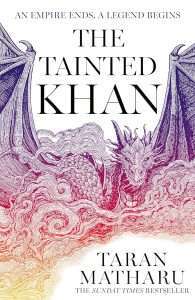 [GdM] Thank you Taran, for taking the time to chat with us about all things The Tainted Khan. For our readers who haven’t yet picked it up, could you give them a teaser of what to expect from the novel?
[GdM] Thank you Taran, for taking the time to chat with us about all things The Tainted Khan. For our readers who haven’t yet picked it up, could you give them a teaser of what to expect from the novel?
[TM] The Tainted Khan is a tale of identity, survival, and reclaiming lost heritage. Readers can expect a sweeping journey across the Great Steppe, where Jai must navigate brutal tribal politics and prove himself worthy of his father’s legacy—armed with little more than a soulbonded dragon and a past that few believe. Expect betrayal, battle, training sequences, ancient customs, and moments of tenderness.
[GdM] The Tainted Khan takes place in a different geographic area to the events of Dragon Rider but I found the settings to be very vividly detailed and was fully immersed whilst reading both novels. How much planning for the world have you had to do? What are your real-world inspirations for it?
[TM] Thank you! Imagining the world of the Great Steppe involved a great deal of historical research—aka my favourite form of procrastination haha. I studied the cultural norms and practices of extinct nomadic and pastoral cultures from all over the world, with a special focus on those living on steppes and plains. In particular, the Sithia were inspired by my own ancestors, the Indo-Scythian Saka peoples.
[GdM] The reader learns a lot more about Jai’s people and his family history in The Tainted Khan and the last time you spoke to Grimdark Magazine you said how you were inspired by the life of Atilla the Hun for Jai. Were there any other historical events that you drew from?
[TM] Definitely. Jai’s story mirrors the fate of many royal hostages from ancient history. I drew from the lives of Mithridates of Pontus, Timur, and even the mythologised early life of Genghis Khan. The tribe’s customs also reflect steppe warrior codes, blended with caste systems reminiscent of feudal India. The Tainted tribes are a direct nod to untouchable classes, and the perpetuation of historical injustice.
[GdM] I think it’s safe to say that there is a bit of a dragon renaissance happening in fantasy now. As someone who loves dragon fantasy, I’m all for that. Why did you choose to focus the Soulbound Saga on dragons rather than any of the other creatures who can be soulbound?
[TM] Dragons are the apex symbol of power and majesty. In a world where the soulbound warriors are central, a dragon is the ultimate companion and weapon of war. Of course for Jai, Winter is more than a mount—they share souls, minds, and history.
Dragons are a force for change, and allow an individual to have the greatest impact, both on and off the battlefield. Other soulbound beasts exist—Griffins, Mammoths, Sabreteeth and Manticores for example are formidable—but dragons challenge the status-quo and upend hierarchies. That’s what I needed for this story.
[GdM] What has is been like having a dragon series come out at the same time as some other very big dragon themed novels?
[TM] I try not to invite too much comparison, especially since the current dragon renaissance is closely tied to romantasy—and Fourth Wing in particular. While we share some of the same trappings—dragons, griffins, bonding, military academies—the DNA is very different. The Soulbound Saga is perhaps more rooted in epic fantasy, focusing on identity, survival, and cultural legacy, with romance playing only a subtle role in the broader narrative.
[GdM] Other than the dragons though, what is your favourite animal in the Soulbound Saga? I love the khiro, but that’s because Navi holds a very special place in my heart.
[TM] Navi is absolutely my favourite too. She’s old, scarred, yet unbroken. The khiroi in general were inspired by prehistoric megafauna, woolly rhinos to be specific, but I wanted to give them the stoicism and empathy one might associate more with horses. That being said, if I had to pick a steed of my own, a griffin edges out a khiro—I’d still want to be able to fly!
[GdM] Do you have a favourite character to write?
[TM] Jai was always my favourite character, but what I enjoyed most was exploring Leonid’s past through his diary, and his legacy. He’s certainly the most complex and morally ambiguous character in the series, and his shadow is cast heavily on this book. I can’t say more than that.
 Author Taran Matharu – Photo Credit Anita Wong
Author Taran Matharu – Photo Credit Anita Wong[GdM] I really loved the magic system within these books, how the mana can pass between two soulbound, its uses, how the cores can change, how the characters have to build up their power etc. What were your inspirations for the magical system?
[TM] I can’t deny that the main inspiration was the Cultivation genre in particular, which I must acknowledge Will White as having popularised in the West, but is very much of Eastern origin. Of course, I had to adapt it to a world of sharing souls with powerful beasts. I also took great inspiration from video games and their impact on the rise of Progression Fantasy, particularly using stored mana as a fuel source for magic.
[GdM] Although Dragon Rider and The Tainted Khan are the first of your books I have read, your writing style really gels with me as a reader. I feel like I’m reading an old favourite even though I’m not. What are your favourite writers or fantasy worlds?
[TM] I must confess, I try not to read too much fantasy when I’m writing, as I do fear accidentally taking too much inspiration from other books in the same space as mine. Consequently, much of my inspiration comes from historical fiction and non-fiction. In particular, Wilbur Smith’s and Bernard Cornwell’s books had the greatest impact on me today and in my formative years as a writer. Growing up, though, I have to acknowledge Redwall as my primary source of fantasy reading—Mossflower is the first book I remember reading, and choosing for myself.
[GdM] I’m always really curious about different writers’ processes. How does yours work? Do you plot everything out in advance? Or do you wing it as you go? What does a typical writing day look like for you?
[TM] I tend to have a blurry vision of the book as a whole that is subject to change as I write it and it solidifies in my mind, but with several key milestones that I am writing between…that also sometimes shift too!
[GdM] Are you able to share anything about what is coming next in the series? Are you planning a trilogy, or writing further stories set in this world?
[TM] It’s definitely a trilogy.
[GdM] What are you working on at the moment?
[TM] Absolutely nothing—it’s time for a break! Although I’m playing with the idea of a post-apocalyptic screenplay. Though it may turn into its own standalone novel instead.
[GdM] Taran, thank you so much for taking the time out of your day to chat with us. I’m so grateful for the chance to learn more about your writing and this world. I’m excited for the next book in the series, but whilst I’m waiting, do you have any reading recommendations for fans of The Soulbound Saga?
[TM] That is an easy one! I have to recommend these dragon rider series: ‘The Bound and The Broken’ series by Ryan Cahill, the ‘Songs of Chaos’ series by Michael R. Miller, and the ‘A Time of Dragons’ series by Philip C. Quaintrell.
Read The Tainted Khan by Taran MatharuThe post INTERVIEW: Taran Matharu appeared first on Grimdark Magazine.




